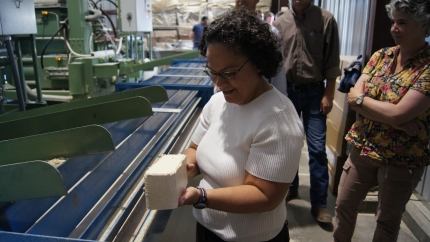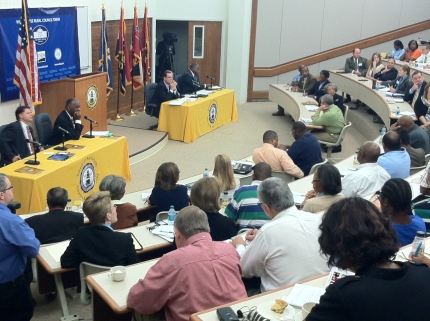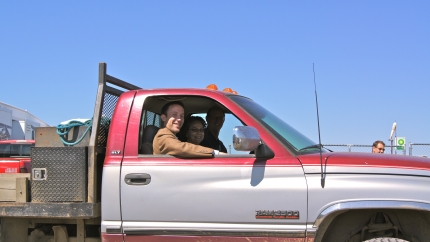Related Rural Blog Posts
Digital Literacy is Part of Job Preparedness
Posted by on August 29, 2011 at 2:51 PM EDTEd. Note: Cross-posted from the NTIA Blog.
Broadband Internet is a catalyst for job creation. In fact, a recent report by McKinsey & Company finds that the Internet has created 2.6 jobs for each job it has eliminated. To take full advantage of the economic opportunities enabled by broadband, however, more Americans need online skills. For instance, broadband service allows a small business owner in rural America to sell her goods to consumers around the world – but online skills are also required.
NTIA’s research shows that nearly one-third of Americans do not use the Internet, leaving them cut off from the online economy. Many are rural Americans, seniors, minorities, people with disabilities, the unemployed, and those with low incomes. The most common reason for not adopting broadband is the perception that it is not needed. But broadband is increasingly needed to find jobs, and 21st century skills are needed to get those jobs.
NTIA is working on several fronts to help bridge this digital divide. Most notably, our Broadband Technology Opportunities Program (BTOP) has invested in approximately 230 projects to expand broadband access and adoption in communities nationwide. Funded by the Recovery Act, BTOP projects have already delivered more than 8,000 miles of broadband networks and installed or upgraded more than 9,000 workstations at public computer centers.
Learn more about Rural, TechnologyWhite House Rural Council Roundtables on Job Growth
Posted by on August 25, 2011 at 5:31 PM EDTEd. Note: Cross-posted in part from The Commerce Blog.
Last week, as part of his three day bus tour, President Obama stopped in Peosta, Iowa to participate in the White House Rural Economic Forum, where he announced a series of initiatives that leverage existing programs and funding to help small businesses and meet the critical needs in rural communities. In the coming weeks, the President will put forth additional proposals that will help put people back to work and give the middle class greater economic security. Promoting economic and job growth in rural communities is central to these goals.
Earlier this week, I traveled to Louisiana, Tennessee and Arkansas with Federal Co-Chairman of the Delta Regional Authority (DRA) Chris Masingill and Doug O'Brien, Deputy Under Secretary for Rural Development at the U.S. Department of Agriculture to conduct project site visits and participate in White House Rural Council Roundtables in Houma and Bastrop, LA as well as Pine Bluff, AR. We heard from stakeholders in the region about how the federal government has and can be a better partner as we invest in rural economies.
On August 26, 2011, U.S. Commerce Department’s Economic Development Administration (EDA) will host a webinar to discuss best practices to promote rural small business development. White House Rural Council members Chris Masingill of DRA and Federal Co-Chairman of the Appalachian Regional Commission (ARC) Earl Gohl will share best practices and successes with close to 400 participants.
Learn more about RuralTreasury Announces Awards to Benefit Low-Income and Distressed Native Communities
Posted by on August 25, 2011 at 3:49 PM EDTEd. Note: Cross-posted from Treasury Notes, the Department of the Treasury blog.
Building upon last month’s announcement of $142 million in awards for distressed communities – the single largest round of awards in the Community Development Financial Institutions (CDFI) Fund’s history – yesterday, I had the privilege of meeting with a national gathering of Native CDFIs in Honolulu, HI where I announced an additional $11.85 million in awards expressly for financial institutions serving Native American, Alaska Native and Native Hawaiian communities.
That money, made under the fiscal year 2011 round of Treasury’s Native American CDFI Assistance Program (NACA Program), will go to 35 organizations with a primary mission of serving low-income and distressed Native communities in 17 states (pdf), the majority of them in rural areas. Of the 35, seven organizations serving Native Hawaiian communities will receive awards that will allow them to increase lending services, start new microloan programs and increase their capacity to serve their target markets.
Conservation, Innovation and Collaboration Creates Jobs in Rural Oregon
Posted by on August 25, 2011 at 10:16 AM EDTAs a forester, I have always believed that smart, common sense initiatives to conserve our lands and waters go hand-in-hand with growing our economy and creating jobs. Under President Obama's leadership, the health of our natural treasures and the communities and economies that they support has seen robust advancement. On a recent fact finding trip to John Day Oregon, I saw this support firsthand. On the Malheur National Forest, a collaborative partnership between local businesses, local government, the Federal Government and conservation groups has restored forest health and reduced wildfire threat while sustaining the local forest products industry and starting a local clean energy market. This allowed a local lumber company to add infrastructure and retain and create new jobs equal to six percent of the non-farm workforce in Grant County. This new clean energy industry is estimated to reduce energy costs by $4.4 million across the regional economy.
This rural economic development success in John Day demonstrates the interdependence of a healthy environment and a strong economy and the good things that happen when local communities and the Federal Government work collaboratively to solve complex problems. This approach is a cornerstone of the President's America's Great Outdoors Initiative (AGO), a 21st century conservation agenda built in partnership with the American people, and reinforces the work of the White House Rural Council.
Established to improve rural economic opportunity and quality of life, the Rural Council is tasked with finding opportunities to enhance collaboration for Federal investments so that innovative developments like the one in Oregon can find success across the country. Throughout August the President and the White House Rural Council have been engaging local leaders in rural America to hear directly from them about the issues and actions that matter to them most.
Rural Americans arguably have one of the strongest ties to, and often live off of, the land which motivates innovative solutions to complex problems. This infrastructure success in John Day represents what the President’s Rural Council will learn and build from and look to repeat across the country: an amazing bottom line of protecting the environment, reducing wildfire threat, creating clean energy, promoting energy independence, and adding local jobs, all while diversifying and strengthening the regional economy. Below local residents in Oregon share their views on how this collaboration with the Federal Government has made a difference for their communities and economy.
Jay Jensen is Associate Director for Land and Water Ecosystems at the White House Council on Environmental Quality
Posted by Cassandra Moseley:
Grant County is a dramatic, arid landscape where, for generations, people have made their livelihoods working the land. But by the late 1990s, battered by a changing global economy and a two-decade conflict over federal land management, businesses had closed, jobs disappeared, and many families had left. In the early-2000s, looking for new solutions, community leaders decided it was time to talk instead of yell. They reached out to their neighbors, environmentalists, and timber industry representatives. These conversations turned into collaboration and then into innovation. They found a willing partner in the U.S. Forest Service. In 2009, the Forest Service's Malheur National Forest began awarding innovative stewardship contracts to implement their restoration projects. Federal investments in forest restoration in Oregon create jobs and these investments create even more jobs when the byproducts of restoration – small trees – are turned into value-added products and energy.
With ecological goals at the forefront, the harvested trees are small. To take advantage of this new timber supply, folks again innovated. The Malheur Lumber Company partnered with an energy company to integrate a new pellet and biobrick facility into their sawmill. With little private financing available, they used a USDA Recovery Act grant, New Market Tax Credits, and other federal programs to fund construction. Today, these products are helping to cleanly heat homes, the local airport, and hospital, while reducing heating costs, decreasing dependence on foreign oil, and creating jobs.
The President's proposed fiscal year 2012 Forest Service budget would accelerate similar innovation in communities like Grant County. By combining line items that contribute to restoration, this modernized budget structure would allow the agency to break out of its silos, address complex problems, integrate restoration and job creation, and improve partnerships.
Cassandra Moseley is the Director of the Ecosystem Workforce Program and Institute for a Sustainable Environment at the University of Oregon

Chair Nancy Sutley visits the Malheur Lumber Company to witness how its innovative pellet and biobricks are created. (Photo Credit: Sustainable Northwest)
Posted by Maia Enzer and Chad Davis:
Transforming our economy while stewarding vast landscapes requires local, regional and national partnerships. That is why Sustainable Northwest and our partners launched the Dry Forest Investment Zone, an initiative catalyzed by the U.S. Endowment for Forestry and Communities' $2 million investment to build strong forest-based rural economies.
Public and private partnerships are critical to achieving results in rural communities. The addition of a pellet mill at Malheur Lumber Company in John Day is a great example. Supply is secured through forest restoration projects. Pellets are being used as a source of renewable energy to provide heat at several community facilities. The use of wood pellet fuel reduces energy costs and offsets the consumption of imported petroleum-based heating fuels keeping dollars spent on local energy.
Throughout our history, rural America has been a stronghold of innovation and resilience. We hope the Rural Council will glean successful models from the entrepreneurial vision of communities like John Day. We need strong conservation-based rural economies. Rural America is where our food, fiber and energy come from, it's where we vacation, and it’s these places that our art and music celebrate. Ultimately, it's these places that will define the future of America.
Maia Enzer is the Policy Director and Chad Davis is the Forest Stewardship Director at Sustainable Northwest
Learn more about Energy and Environment, RuralA Step Toward better Housing and Economic Development in Indian Country
Posted by on August 24, 2011 at 6:34 PM EDTEd. Note: Cross-posted from The HUDdle.
I was in Albuquerque yesterday to announce $28 million in HUD funding to help rural communities across the country tackle their toughest housing and poverty challenges. I was joined by tribal leaders in New Mexico as I shared that more than half of the funds, $15.6 million, went to 27 Native American tribes or communities across the nation.
I’m not surprised there was a strong showing of communities in Indian Country finding innovative solutions to address some of our most difficult challenges. Economic development is particularly crucial in Native American communities.
The Rural Innovation Fund Grants promote an entrepreneurial approach to addressing affordable housing and economic development in rural areas – and at the heart of this movement are Native American tribes and leaders. The grants will lead to nearly 800 new homes and more than 650 jobs nationwide, and leverage an extra $18 million in investments. We know each tribe and American Indian community is different, facing different challenges and opportunities. That is why the new Rural Innovation Fund offers flexible resources that allow communities to address either housing or economic development needs, or both.
Learn more about RuralThe American Family of Governments, Working Together to Strengthen America’s Economy
Posted by on August 23, 2011 at 11:43 AM EDTFrom Jefferson Keel, the current President of the National Congress of American Indians and the Lt. Governor of the Chickasaw Nation, on his experience participating in the White House Rural Economic Forum in Iowa:
Like so many of our rural neighbors, American Indian and Alaska Native communities have felt the burden of our nation’s economic challenges. In fact tribal nations have known hardship like this for too long. That is why the efforts of the White House to find economic development solutions for Indian Countryhave been so important to tribal leaders and entrepreneurs. It’s also the reason I accepted the invitation to join other rural leaders in Iowa to have an important conversation with President Obama and Secretaries Vilsack, Salazar, Donovan, and LaHood about the economic viability of our country, including our tribal nations. The discussions with the President and Secretaries were constructive and encouraging.
The White House Rural Council, established this past June, is a flagship effort that shows President Obama is serious about building a strong economic future for all Americans. The fact that tribes have a seat at the table as rural policy is considered is a reflection of a commitment to the nation-to-nation relationship that began even before the President took office. It is a commitment that acknowledges the need to address the challenges tribes face and sees the innovation tribal nations offer to build a stronger America.
Native people are America’s most rural population and tribal lands consist of over five percent of the nation’s land base (an area that would make Indian Country the nation’s fourth largest state). While many of our communities are among the poorest in the country and unemployment rates in Indian Country often stand above 50 percent, tribes are leading the way in developing and implementing innovative policy.
Learn more about Rural
- &lsaquo previous
- …
- 13
- 14
- 15
- 16
- 17
- 18
- 19
- 20
- 21
- …
- next &rsaquo

